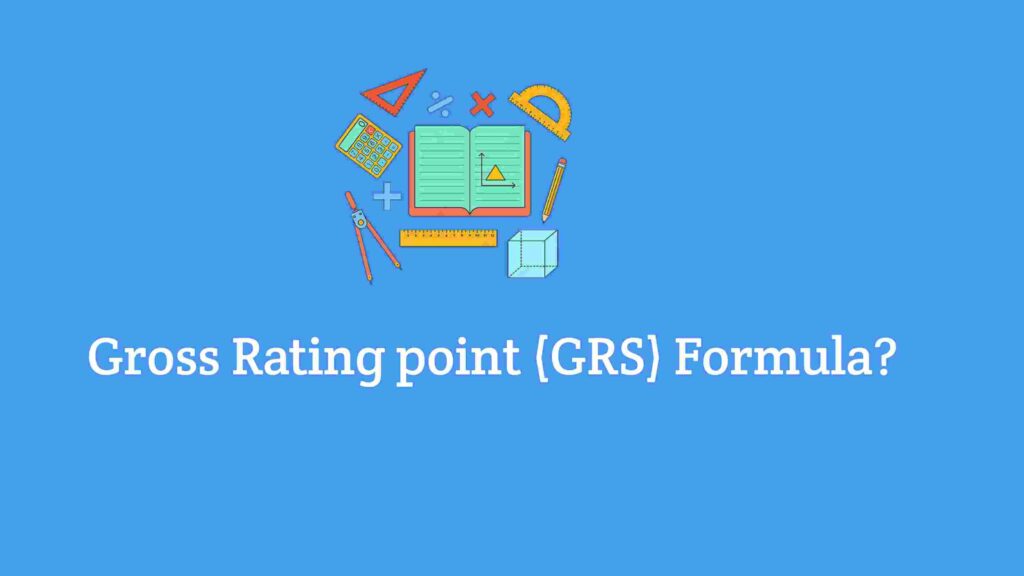Gross Rating Point (GRS) It is a metric that is widely used in digital marketing to analyse the advertisement campaign. It defines the impressions or reach of a particular advertisement in relation to the target audience.
Let’s break down what a Gross rating point (GRP) is and how it is calculated :
Topics covered in this Article
- 1 Definition of Gross rating point (GRP)
- 2 How to Calculate Gross rating point (GRP)
- 3 Example Scenario of Gross rating point (GRP)
- 4 Why GRP (Gross Rating Point) is Important for Business:
- 5 Importance of Gross Rating Points (GRP):
- 6 What is a good gross rating point (GRP)?
- 7 How do you improve Gross Rating Points (GRP)?
- 8 How can gross rating points help in digital marketing?
Definition of Gross rating point (GRP)
GRP represents the sum of all the rating points achieved by an advertising campaign. One rating point corresponds to one percent of the target audience.
Formula for Gross rating point (GRP) : GRP = Reach (%) x Frequency
How to Calculate Gross rating point (GRP)
- Formula : GRP = Reach (%) x Frequency
- Reach: The percentage of the target audience that is exposed to the advertisement at least once.
- Frequency: The average number of times the target audience is exposed to the advertisement.

Example Scenario of Gross rating point (GRP)
Imagine you are running a digital marketing campaign for a new product. You have defined your target audience, and you want to measure the effectiveness of your campaign using GRP.
- Target Audience: 1,000,000 people
- Reach: 40% of the target audience
- Frequency: The average person in the target audience sees the ad 3 times during the campaign.
Let’s calculate the gross rating point (GRP):
- Determine Reach:
- Reach is the percentage of the target audience exposed to the ad at least once.
- In this case, 40% of 1,000,000 people.
- Reach (in numbers) = 1,000,000 * 0.40 = 400,000 people
- Calculate Frequency:
- Frequency is the average number of times each person in the target audience sees the ad.
- Here, the frequency is given as 3.
- Apply the GRP Formula:
- GRP = Reach (%) x Frequency
- Reach (%) is already given as a percentage (40%).
- So,
- GRP = 40% * 3
- GRP = 40 * 3
- GRP = 120
Explanation
- Reach: 40% means 400,000 out of 1,000,000 people saw the ad.
- Frequency: On average, each of those 400,000 people saw the ad 3 times.
- GRP: The campaign achieves a total of 120 GRPs.
Why GRP (Gross Rating Point) is Important for Business:
GRP is a key measure in advertising that helps businesses understand how many people are seeing their ads. The following are some reasons why it’s important:
- Measures Impact: It helps gauge the effectiveness of a campaign by determining the number of times your ads are seen (reach) and how often they are seen (frequency).
- Comparing Campaigns: By comparing marketing campaigns, businesses can find out which one works best.
- Smart Spending: Businesses can make informed decisions about where to spend their advertising budget for the best results by knowing the GRP.
- Setting Goals: In order to set targets and measure success, GRP provides a benchmark.
- Planning Ads: Ad campaigns are more effective when they are launched at the right time and through the right mix of media channels.
Importance of Gross Rating Points (GRP):
Gross Rating Points (GRP) are a very important point in marketing as they measure the total exposure of an ad campaign by combining reach (the percentage of the target audience) and frequency (the average number of exposures per person).
GRPs help in media planning, campaign comparison, performance benchmarking, and strategic decision-making, enabling marketers to optimize budget allocation, justify expenditures, and ensure effective audience engagement.
What is a good gross rating point (GRP)?
A good Gross Rating Point (GRP) varies by industry and campaign goals, but generally, a GRP of 100 means that the ad impressions are equivalent to the entire target audience seeing the ad once.
Effective GRPs typically range from 150 to 300, balancing sufficient reach and frequency to ensure the ad resonates with the target audience without causing overexposure.

How do you improve Gross Rating Points (GRP)?
To improve Gross Rating Points (GRP), consider the following strategies:
- Increase Reach: Expand the audience base by targeting additional demographics, geographic areas, or new platforms.
- Enhance Frequency: Increase the number of times your target audience sees the ad by running the campaign more frequently or over a longer duration.
- Optimize Media Mix: Use a combination of different media channels (TV, online, radio, print) to maximize exposure and reach a broader audience.
- Improve Ad Quality: Create engaging, high-quality ads that resonate with the audience, encouraging repeated views and shares.
- Target Peak Times: Schedule ads during peak viewing times or high-traffic periods to maximize visibility.
- Leverage Data Analytics: Use data analytics to understand audience behavior and preferences, enabling more effective targeting and ad placements.
How can gross rating points help in digital marketing?
- Simplicity: GRPs offer a straightforward way to measure and communicate the scale of an advertising campaign.
- Comparability: They allow for easy comparison between different campaigns, time periods, and media channels.
At the end, GRP is mainly focused on getting a large amount of reach and frequency on digital platforms such as display ads, video ads, and social media campaigns. GRP ensures the ads are seen by as many people as possible, the desired number of times. It is similar to traditional marketing, where billboards have a large reach but no frequency.

